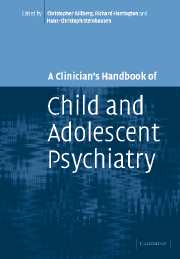Book contents
- Frontmatter
- Contents
- Preface
- List of contributors
- 1 Brain disorders
- 2 Substance use disorders
- 3 Schizophrenia and schizophrenia-like disorders
- 4 Affective disorders
- 5 Anxiety disorders
- 6 Obsessive-compulsive disorders
- 7 Adjustment disorders
- 8 Post-traumatic stress disorder
- 9 Functional somatic symptoms and somatoform disorders in children
- 10 Eating disorders: anorexia nervosa and bulimia nervosa
- 11 Sleep disorders
- 12 Personality disorders
- 13 Mental retardation/learning disability
- 14 Specific developmental disorders of speech and language
- 15 Reading and other learning disorders
- 16 Autism spectrum disorders
- 17 Hyperkinetic disorders
- 18 Conduct disorders
- 19 Elective mutism
- 20 Attachment and disorders of attachment
- 21 Tic disorders
- 22 Elimination disorders: enuresis and encopresis
- 23 Physical and sexual abuse
- 24 Gender identity disorders
- Index
- References
12 - Personality disorders
Published online by Cambridge University Press: 06 August 2009
- Frontmatter
- Contents
- Preface
- List of contributors
- 1 Brain disorders
- 2 Substance use disorders
- 3 Schizophrenia and schizophrenia-like disorders
- 4 Affective disorders
- 5 Anxiety disorders
- 6 Obsessive-compulsive disorders
- 7 Adjustment disorders
- 8 Post-traumatic stress disorder
- 9 Functional somatic symptoms and somatoform disorders in children
- 10 Eating disorders: anorexia nervosa and bulimia nervosa
- 11 Sleep disorders
- 12 Personality disorders
- 13 Mental retardation/learning disability
- 14 Specific developmental disorders of speech and language
- 15 Reading and other learning disorders
- 16 Autism spectrum disorders
- 17 Hyperkinetic disorders
- 18 Conduct disorders
- 19 Elective mutism
- 20 Attachment and disorders of attachment
- 21 Tic disorders
- 22 Elimination disorders: enuresis and encopresis
- 23 Physical and sexual abuse
- 24 Gender identity disorders
- Index
- References
Summary
Introduction and concepts
‘Personality disorder’ (PD) is a term that is used in a variety of ways, some helpful and some less so. It can be synonymous with ‘not treatable’, ‘not within the remit of mental health services’, or even ‘nasty’. This chapter does not refer to any of these. We are referring to relatively persistent maladaptive behaviours and patterns of interpersonal and social role functioning, that are not readily accounted for by discrete episodes of psychiatric disorder.
The available definitions of personality disorder specify that it cannot be diagnosed before age 18. In many respects this simply reflects that many of the identifying features of the personality disorders refer to functioning within adult social roles. It might also be sensible to reserve the term for adults if it were clear that childhood and adolescence is essentially a period of transition and change, contrasted with adult life as a time during which change is unlikely, and if it were to be used to denote that the problems were not open to change. However there is ample evidence for strong continuities in some relevant characteristics, such as aggression and anxious inhibition over childhood and adolescence, and for the possibilities for change during adult life. Furthermore, it is not helpful to include inability to change in the definition of personality disorder. That is an issue that is available for empirical study in relation to different patterns of disorder.
- Type
- Chapter
- Information
- A Clinician's Handbook of Child and Adolescent Psychiatry , pp. 339 - 363Publisher: Cambridge University PressPrint publication year: 2006
References
- 1
- Cited by



